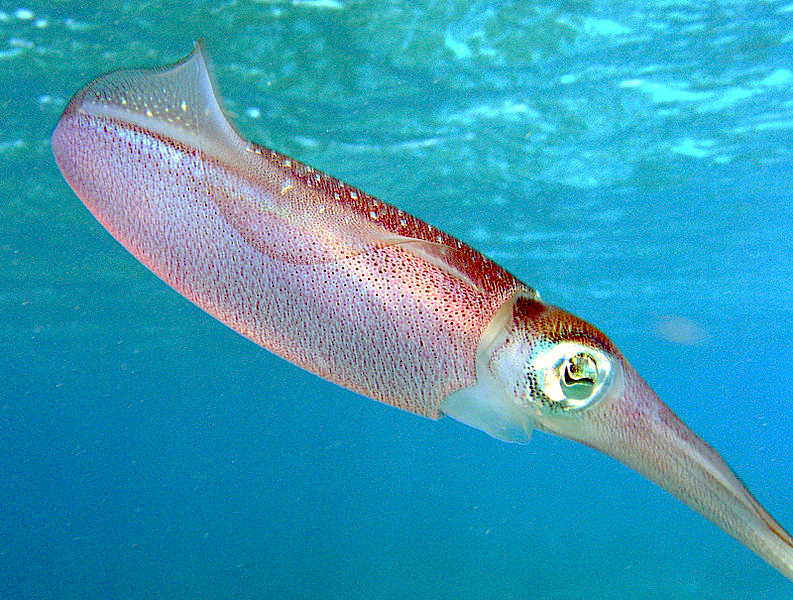The Carribbean Reef Squid
>> Friday, July 24, 2009
I went snorkeling yesterday with my hubby at Secret Harbor on the East End and one of the many forms of sea life I saw was the Caribbean Reef Squid (Sepioteuthis sepioidea). Now you may not have realized it yet, but I have a thing for invertebrates, so I was inspired to do this post. Plus, I had some groovy lab drawings from a squid dissection that I labeled on the compy for you. If you have any questions about the functions of any of the parts labeled, just let me know so that I can answer any questions for you. This is just the basics of this really alien and beautiful creature.
This squid is commonly found throughout the Caribbean and Floridian waters. They are usually found in shallow waters (1 meter or less) and are commonly seen in schools. I usually see between 5 and 15, but apparently will congregate in groups as large as 40. They are mollusks so, believe it or not, are related to the Queen Conch I posted about last week. Since they are further classified as cephalopods, they are more closely related to octopuses, cuttlefish, nautiluses and more. They are quite pretty and many time I have seen them flash colors at each other or in time. They are very colorful, almost iridescent creatures. The speed of color change in them is quite fast as well. In fact, they can change color much faster than a chameleon.
They swim (or hover) using the fins (click image below for larger view) on the sides of the mantle. If they need to get away quickly, they use a form of jet propulsion. If they still can't get away, they ink.
When they aren't hovering, they eat. They eat a lot. The Caribbean Reef Squid, like most squid can consume almost 50% their body weight in food a day. They are carnivores and eat a variety of prey including crustaceans, small fish, and even other mollusks.
One of the things that makes squid and cephalopods so interesting to study is their fantastic sight. The reason they are so studied is they are not even close to being related to vertebrates, yet process images similar to us. This means that their sight and eyes evoloved independently. The main differences are the ammount of visual pigment. They usually have one, we have three. They pretty much only see in greyscale, which is suprising considering the amazing display of colors they put on for us! There is one exception, however, but we won't complicate things. You can learn more about the coevolution and how their eyes work here.
 fig 3. internal anatomy of male squid
fig 3. internal anatomy of male squidSquid are know to be "weed like" in how they grow and reproduce. There are only about 800 species but in terms of production can keep up with fish. This makes fish an incaluable resource globally. The common market squid in Southern California (Loligo opalescens) alone is responsible for about $20 million in revenue a year. That is just the fishery side as well. That does not include uses for its ink, the money made in restaurants that sell it, or the money made from bait and tackle, etc. Due to its fast rate of reproduction, it is alsoconsidered one of the more sustainable types of seafood you could eat. Many questions have yet to be answered though. We don't know where many of these species spawn and just how many are out there. There was a great article published that attempts to show the effects of squid fishereies.
Besides all the info I just gave you, did I mention that they are awesome to swim with? I've only seen them at a few beaches here and absolutely everytime I see them, it's mesmerizing.
I hope you enjoyed my sketches. Happy learning!
Besides all the info I just gave you, did I mention that they are awesome to swim with? I've only seen them at a few beaches here and absolutely everytime I see them, it's mesmerizing.
I hope you enjoyed my sketches. Happy learning!















6 comments:
i have never seen one of these. question : what is the diff btween squid and octopus?
Recent blog:=- Bring your Soggy Dollars!
squid have 8 legs and two club tentacles. Octopus only have 8 legs. Squid also have those neat fins on their mantles while octopus generally do not. Squid are longer while octopus are more bulbous and squid are pelagic (live in open ocean) while octopus are generally benthic (live at the bottom). Also, squid have "teeth" on their suckers and octopuses do not. There are lots more differences, but these are the obvious ones.
Recent blog:=- The Carribbean Reef Squid
great question by the way!
Recent blog:=- The Carribbean Reef Squid
This is a great blog, I really enjoyed it. I would love to see something like this. I don't remember seeing one when I was over there visiting. This one is really awesome. Glad you enjoyed your day with the hubs.
You saw some at Hull Bay!!! They were red that day when you went out with Nick! lol
Recent undefined:=-
ooooooohhhhhhhhh lol well there u go, my brain again. xo
Post a Comment